Whether stumbled upon in a nest that has been disturbed or discovered on the ground without any signs of parental care, abandoned bird eggs evoke a sense of responsibility and concern.
However, it is essential to approach this situation with caution and make informed decisions that prioritize the well-being and conservation of wild birds.
When we come across abandoned bird eggs, it is crucial to remember that birds are protected by wildlife laws in many countries, and interfering with their nests or eggs without proper authorization is often illegal.
In this guide, we will explore the recommended steps to take when encountering abandoned bird eggs while also emphasizing the significance of respecting wildlife and adhering to legal guidelines.
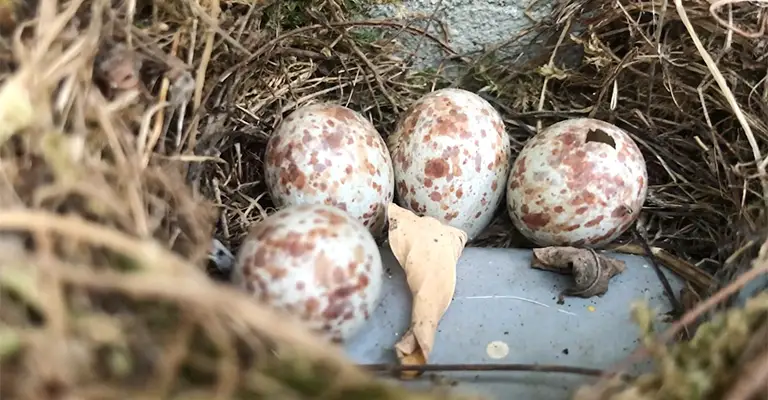
6 Steps to Follow When You’ll See an Abandoned Bird Egg
When you across an abandoned bird egg, you can help it by following a few easy steps. Check them right below.
Step 1: Determine if the Egg is Genuinely Abandoned
Before assuming that the nest is abandoned, it is important to observe it for a reasonable period. Parent birds may leave the nest temporarily to search for food or defend their territory.
By patiently observing the nest for several hours or even a day, you can determine if the parents have genuinely abandoned the eggs.
Keep in mind that different bird species may exhibit varying incubation behaviors, so it is essential to be familiar with the habits of the specific species in question.
During your observation, pay attention to any signs of parental activity. Watch for the return of the parents to the nest, as they may alternate incubation duties or briefly leave to ensure the eggs remain at an appropriate temperature.
Take note of how long it has been since you last saw the parents at the nest, as this will help inform your decision-making process.
Step 2: Check the Condition of the Eggs
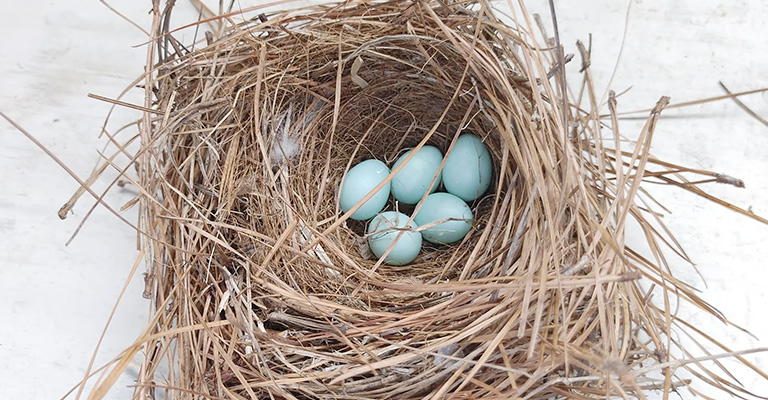
Once you have determined that the nest is indeed abandoned, it is time to assess the condition of the eggs. Carefully examine each egg, looking for any visible signs of damage or abnormalities.
Cracked, broken, or significantly different-looking eggs may indicate that they are non-viable, meaning the embryos inside may not have survived or will not develop properly.
In such cases, it is unlikely that returning the eggs to the nest would result in successful hatching.
On the other hand, intact eggs that appear similar in size, shape, and color to the other eggs in the nest suggest that they have a chance of being viable.
It is important to handle these eggs with extreme care to avoid causing harm to any potentially developing embryos inside.
Step 3: Considering Safety and Accessibility
Before attempting to access the nest, it is crucial to assess the safety risks involved. Consider factors such as the location of the nest, its height from the ground, and the stability of the surrounding area.
If accessing the nest requires climbing a tree or using a ladder, ensure you have the necessary equipment and expertise to do so safely.
Wearing appropriate protective gear, such as gloves, can provide added safety when handling the eggs. Some bird species may exhibit defensive behaviors when their nest is approached, so be cautious and prepared for potential reactions from protective parents.
Minimizing Disturbance to the Nest and Its Surroundings:
Birds are highly sensitive to disturbances around their nests, and excessive interference can disrupt their breeding and nesting behaviors.
To minimize disturbance, it is crucial to approach the nest with caution and maintain a respectful distance whenever possible.
Avoid touching or moving the nest itself, as this can cause further stress and potential harm to the eggs. Minimize any noise or sudden movements that could startle the birds or attract attention to the nest.
Take care not to damage or disturb the surrounding vegetation or habitat while accessing the nest. Preserve the natural environment to ensure the continued suitability of the area for nesting birds.
If the nest is located in a highly trafficked or public area, it may be best to seek professional advice or assistance from local wildlife authorities or rehabilitators. They can provide guidance on the best course of action while minimizing disturbance and ensuring the well-being of the eggs.
Step 4: Returning the Eggs to the Nest
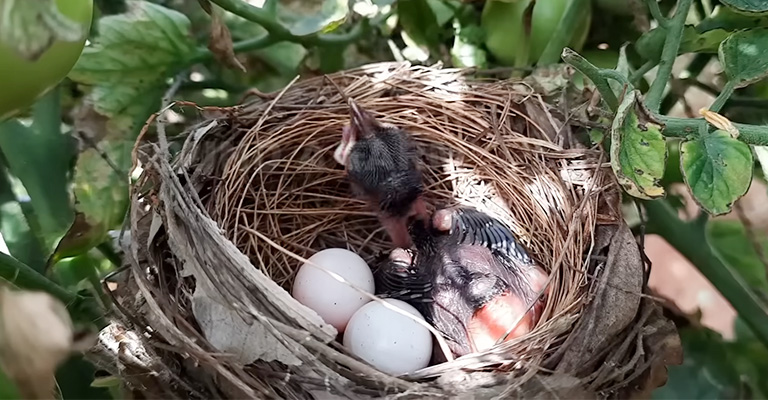
When handling bird eggs, it is crucial to minimize any potential harm to the delicate embryos inside. Eggs can be easily damaged, and excessive handling or rotation can disrupt the development process or cause injury.
First and foremost, ensure that your hands are clean to avoid transferring any harmful substances to the eggs. If available, wearing clean gloves can provide an additional layer of protection.
Gently cup the egg in your hand, cradling it with your fingers to support its weight. Avoid squeezing or applying excessive pressure to the egg. It is essential to minimize any shaking or jostling of the egg to prevent harm to the developing embryo.
If the egg is dirty or has debris on its surface, you can use a soft, damp cloth or tissue to gently clean it. Avoid using any chemicals or cleaning agents, as they can be toxic to the embryo.
Placing the Eggs Back in the Nest Securely:
When returning the eggs to the nest, aim to recreate the original arrangement as closely as possible. It is important to maintain the correct orientation of the eggs and ensure they are placed securely within the nest.
Approach the nest slowly and cautiously, minimizing disturbances as much as possible. Carefully place the eggs back into the nest one by one, using a gentle and steady hand.
Try to disturb the nest material as little as possible during the process.
Observe the position and orientation of the other eggs in the nest before placing the newly returned egg. Match the alignment and placement of the eggs to ensure a consistent incubation environment.
Make sure the eggs are stable and well-supported within the nest. Avoid leaving any eggs precariously balanced or at risk of rolling out of the nest.
Once all the eggs have been returned, carefully and slowly withdraw from the nest area to minimize further disturbance.
Step 5: Monitoring and Giving Space
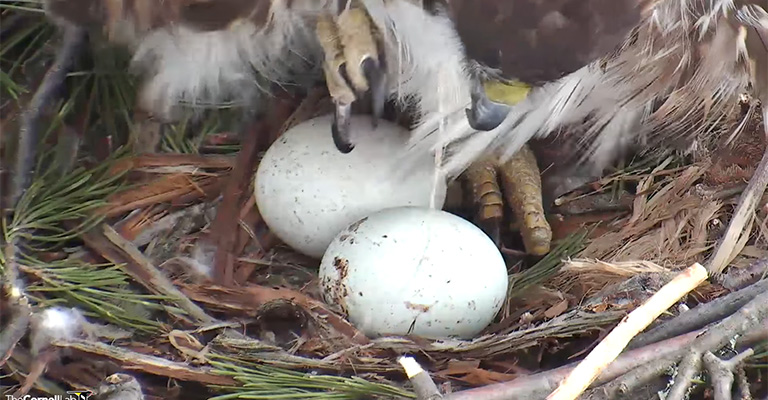
Once you have securely placed the eggs back in the nest, it is crucial to observe the nest from a distance. This allows the parents the chance to locate the eggs and resume their incubation duties without feeling threatened or disturbed.
Find a suitable vantage point where you can see the nest without getting too close. Use binoculars or a zoom lens on a camera if needed to maintain a safe distance.
By observing from afar, you can monitor the nest for any signs of the parents’ return.
Step 6: Avoiding Frequent Visits and Prolonged Monitoring
While it is natural to be concerned about the well-being of the eggs, it is important to strike a balance between monitoring and allowing the parents their space.
Frequent visits to the nest or prolonged monitoring can disrupt the birds’ nesting behavior and increase their stress levels.
Limit your visits to the nest to essential observations, such as checking for the presence of the parents or any signs of activity. Keep your visits brief and minimize any disturbances in the vicinity of the nest.
If you notice the parents returning to the nest, be mindful of their presence and quickly withdraw from the area to avoid causing further disturbance.
Seeking Professional Guidance
If you are unsure about the appropriate course of action or have concerns about the abandoned bird eggs, it is recommended to reach out to local wildlife authorities or rehabilitators.
These professionals have expertise in handling wildlife situations and can provide accurate and species-specific guidance.
Contact your local wildlife or conservation agency to inquire about the appropriate contacts for seeking advice. They can direct you to licensed wildlife rehabilitators or specialists who are knowledgeable about local bird species and their nesting behaviors.
When contacting these professionals, provide them with relevant details about the situation, including the species of bird, the condition of the eggs, and any observations you have made. This information will assist them in providing tailored guidance based on the specific circumstances.
Legal Regulations and Authorized Protocols
In many regions, there are legal regulations in place to protect wildlife, including nesting birds and their eggs. It is essential to familiarize yourself with these regulations and understand the permitted actions and restrictions regarding bird nests and eggs.
Respecting legal regulations is crucial for wildlife conservation and helps maintain the ecological balance. Some jurisdictions require permits or specific authorization to handle or disturb bird nests or eggs, even if they appear abandoned.
Violating these regulations can result in legal consequences and may disrupt conservation efforts.
When seeking professional guidance, ensure that you follow authorized protocols and abide by any permits or guidelines provided. Professionals will be well-versed in the applicable regulations and will offer advice within the legal framework.
Importance Wildlife Protection
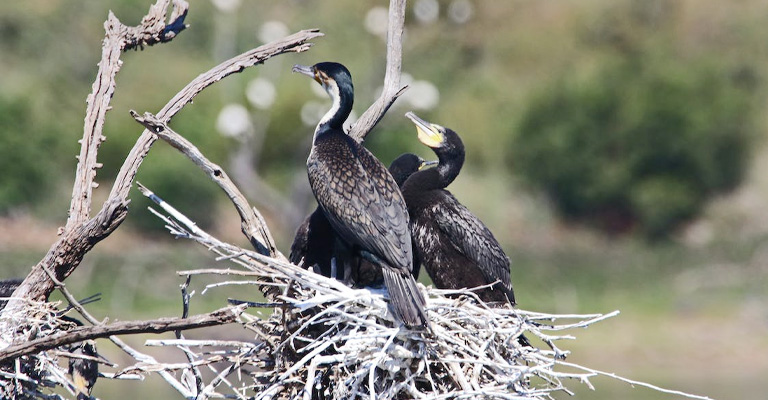
Wildlife conservation plays a vital role in maintaining biodiversity, preserving ecosystems, and ensuring the long-term survival of species.
Birds, as an essential component of ecosystems, contribute to pollination, seed dispersal, and pest control.
Protecting their nests and eggs is essential for maintaining healthy populations and ecological balance.
Abandoned bird eggs, although seemingly insignificant on their own, contribute to the natural cycle of life and hold the potential for new individuals to join the population.
By understanding the value of wildlife conservation, we recognize the importance of protecting these eggs and their inherent role in sustaining bird populations and ecosystem functions.
Conservation efforts extend beyond individual actions and involve collective responsibility. By valuing wildlife conservation and promoting awareness, we can contribute to the preservation of not only bird species but also the entire natural world.
Promoting Responsible Behavior Towards Wildlife and Their Habitats
Responsible behavior towards wildlife and their habitats is essential for their well-being and survival. It involves respecting the natural behaviors and needs of wildlife while minimizing human disturbances and impacts.
When encountering abandoned bird eggs, responsible behavior includes refraining from unnecessary disturbance or intervention unless necessary or authorized.
Respecting nesting sites, keeping a safe distance, and avoiding actions that may cause stress or harm to the birds are all part of responsible behavior.
Promoting habitat conservation is equally important. Preserving natural habitats, providing suitable nesting areas, and protecting biodiversity ensure the availability of resources and safe spaces for birds and other wildlife to thrive.
Education and awareness play a significant role in fostering responsible behavior. By sharing knowledge about wildlife conservation, the importance of undisturbed nesting areas, and the role individuals can play in preserving habitats, we can inspire others to act responsibly and make informed choices.
Ultimately, responsible behavior towards wildlife and their habitats is a collective effort that requires collaboration between individuals, communities, and organizations.
Actions for Dealing With Abandoned Bird Eggs
| Topic | Key Actions |
| Assessing the Situation | Determine if the nest is genuinely abandoned |
| Evaluate the condition of the eggs for viability | |
| Considering Safety and Accessibility | Ensure personal safety when accessing the nest |
| Minimize disturbance to the nest and its surroundings | |
| Returning the Eggs to the Nest | Handle the eggs with care to prevent harm |
| Place the eggs back in the nest securely | |
| Monitoring and Giving Space | Observe the nest from a distance to allow parents to return |
| Avoid frequent visits and prolonged monitoring | |
| Seeking Professional Guidance | Contact local wildlife authorities or rehabilitators |
| Respect legal regulations and authorized protocols | |
| Understanding Wildlife Protection | Highlight the importance of wildlife conservation |
| Promote responsible behavior towards wildlife and habitats |
FAQs
It is generally not recommended for individuals to attempt hatching abandoned bird eggs at home. Proper incubation requires specific temperature and humidity control, as well as specialized knowledge and equipment.
It is best to leave incubation to the natural instincts and abilities of the bird parents or seek assistance from licensed wildlife rehabilitators.
If you accidentally disturbed an active bird nest, the best course of action is to minimize further disturbance and give the parents a chance to return.
Step away from the nest area and observe from a distance. Avoid interfering with the nest or handling the eggs unless necessary or under professional guidance.
In the future, it is important to be mindful of bird nests and avoid unnecessary disturbance to their habitats.
If you find a fallen bird nest with eggs on the ground, you can attempt to carefully place the nest back in its original location, if feasible. However, it is important to note that the chances of successful hatching and parental care may be reduced in such cases.
If you are unsure or have concerns, it is best to consult local wildlife authorities or rehabilitators for guidance.
If you come across injured or abandoned baby birds near the nest, it is recommended to contact local wildlife authorities or licensed rehabilitators immediately.
They have the expertise to assess the situation and provide appropriate care. Do not attempt to care for or feed the birds on your own, as their dietary and care needs can be specific and require professional knowledge.
The time required to determine if a nest is truly abandoned can vary depending on the species and circumstances. It is recommended to observe the nest for at least several hours, or even up to a day, to allow for possible temporary absences by the parents.
If there are no signs of parental activity or return after this period, it may indicate abandonment. However, if you are unsure, it is best to seek advice from local wildlife authorities or rehabilitators.
Conclusion
Dealing with abandoned bird eggs requires careful assessment, responsible actions, and respect for wildlife. It is essential to observe the nest, evaluate the condition of the eggs, handle them with care, and respect legal regulations. Thus, we can contribute to the well-being of the eggs and the preservation of bird species.
So, let’s promote conservation and responsible behavior towards wildlife. Also, share your thoughts with us and let us know if you have any suggestions in this context. Thank you.